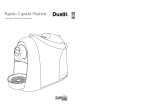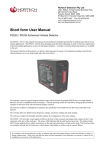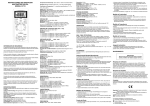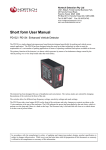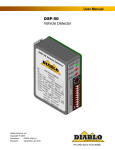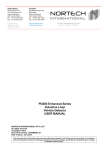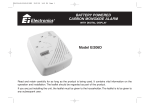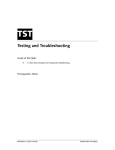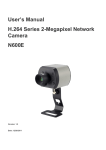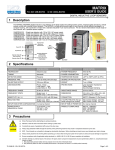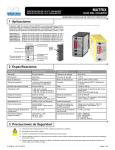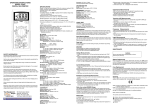Download AGP-0230 Dual Channel Vehicle Detector
Transcript
This document is for information only and unless otherwise indicated it is not to form part of any contract. In accordance with the manufacturer’s policy of continually updating and improving design, specifications contained herein are subject to alterations without notice. AGP-0230 USER MANUAL AMANO Copyright © 1996 Document No. : 302UM0003-00 Date of issue : March 1996 Table of Contents 1. INTRODUCTION................................................................................................ 1 2. TECHNICAL DATA............................................................................................ 2.1 Functional Data.................................................................................................... 2.2 Electrical Data...................................................................................................... 2.3 Functional Data.................................................................................................... 2.4 Mechanical Data.................................................................................................. 2 2 3 3 3 3. OPERATING INSTRUCTIONS......................................................................... 3.1 Hardware Set-up.................................................................................................. 3.2 Switching Setting Selections............................................................................... 3.2.1 Frequency Switching...................................................................................... 3.2.2 Sensitivity........................................................................................................ 2.3.3 Automatic Sensitivity Boost............................................................................ 2.3.4 Presence Time................................................................................................. 2.3.5 Reset Switch.................................................................................................... 2.3.6 Internal Link Selection.................................................................................... 3.3 Front Panel Indicator........................................................................................... 4 4 5 5 5 6 6 6 6 7 4. PRINCIPLE OF OPERATION........................................................................... 8 4.1 Detector Tuning................................................................................................... 8 4.2 Detector Sensitivity.............................................................................................. 9 4.3 Modes of Operation............................................................................................. 9 4.4 Response Time..................................................................................................... 10 5. INSTALLATION GUIDE 5.1 Operational Constraints....................................................................................... 5.2 Loop and Feeder Specifications.......................................................................... 5.3 Sensing Loop Geometry...................................................................................... 5.4 Loop Installation.................................................................................................. 11 11 12 12 12 6. CONFIGURATION............................................................................................. 6.1 AGP-0231 Detector............................................................................................. 6.2 AGP-0232 Detector............................................................................................. 6.3 AGP-0234 Detector............................................................................................. 15 15 15 16 7. APPLICATIONS.................................................................................................. 17 8. CUSTOMER FAULT ANALYSIS..................................................................... 8.1 Fault Finding........................................................................................................ 8.2 ADU-0100 - Detector Diagnostic Unit................................................................ 8.3 Functional Test.................................................................................................... 18 18 19 20 AGP-0230 Page i User Manual SAFETY PRECAUTION : - Ensure that Electric Power has been turned off before opening the unit. AGP-0230 User Manual Page ii 1. INTRODUCTION The AGP-0230 is a dual channel microprocessor based detector designed specifically for parking and vehicle access control applications. The AGP-0230 has been designed using the latest technology in order to meet the requirements of a vast number of parking applications in terms of operating conditions. A number of internal function options are available to the user. The primary function of the detector is to detect vehicle presence by means of an inductance change caused by the vehicle passing over a wire loop buried under the road surface. The detector has been designed around the popular AGP-0130 series of single channel detectors for ease of installation and convenience. The various modes are selected by changing the position of switches on the front of the unit. The detector oscillator is multiplexed to eliminate any possibility of crosstalk between the loops connected to the detector. The switches allow for different loop frequency settings, sensitivity settings and mode settings. The unit has a number of initial selectable options for configuration of the relay outputs. The AGP-0230 provides visual outputs ( LED ) on the front of the enclosure and relay change-over contacts at the 11 pin connector at the rear of the enclosure. The power LED indicates that the unit has been powered. The channel status LED’s below indicate that a vehicle is present over the loop and when there is a fault on the loop. The Presence relays are normally fail-secure and will close on a vehicle detect or loop failure but not if there is a power failure. AGP-0230 User Manual Page 1 of 20 2. TECHNICAL DATA 2.1 Functional Data Tuning Fully automatic Self-tuning range 20 to 1500µH Sensitivity Four step switch selectable High 0.02% , L/L Medium High 0.05% , L/L Medium Low 0.10% , L/L Low 0.50% , L/L Frequency Four step switch selectable Frequency dependent on loop size Automatic Sensitivity Boost Switch selectable Modes Output relays operate in the Presence ( fail-secure ), Pulse or Direction logic modes Presence Time Switch selectable: Limited presence Permanent presence Pulse Output Duration 150/250 millisecond options Response Times 100 milliseconds Drift Compensation Rate Approx. 1% , L/L per minute Visual Indication 1 x Power LED - Red 2 x Channel Status LED - Green Relay Outputs 2 x Relays rated - 5A @ 230 VAC Reset Reset by push button on front of enclosure Surge Protection Loop isolation transformer, gas discharge tubes, and Zener diode clamping on loop input AGP-0230 User Manual Page 2 of 20 2.2 Electrical Data Power requirements 12 - 24V AC/DC ± 15% ( AGP-0234 ) 120V AC ± 15% ( 48 to 60Hz ) 230V AC ± 15% ( 48 to 60Hz ) Requirement: 1.5 VA Maximum at 230V 2.3 Environmental Data Storage Temperature -40°C to +85°C Operating Temperature -40°C to +85°C Humidity Circuit Protection Up to 95% relative humidity without condensation Conformal coating over the PCB and all components 2.4 Mechanical Data Housing material ABS blend Mounting Position Shelf or DIN rail mounting Humidity 11-pin submagnal type ( 86CP11 ) Size of Housing AGP-0230 76mm ( High ) x 39mm ( Wide ) x78mm ( Deep ) User Manual Page 3 of 20 3. OPERATING INSTRUCTIONS 3.1 Hardware Set-up The AGP-0230 dual channel parking detector is designed to be shelf or DIN rail mounted with the controls and visual indicators at the front and wiring at the rear of the enclosure. The power, loop and relay outputs are all connected to the single 11-pin plug which is mounted at the rear of the enclosure. 3.2 Switch Setting Selections AGP-0230 User Manual Page 4 of 20 3.2.1 Frequency Switch The frequency switches are the lower two switches, numbered 1 and 2. There are four frequency selections and are set out as follows: SW2 Off On Off On SW1 Off - High Off - Medium-High On - Medium-Low On - Low The frequency switches allow the loop frequency to be shifted higher or lower depending on the switch position. The frequency of the loop is determined by the loop size, and the frequency of the switch simply causes a frequency shift on the loop. Where more than one detector is used the detectors must be set-up to ensure that there is no cross-talk (interference) between the detectors. This can be achieved by ensuring that the loops of the two detectors are spaced sufficiently apart ( approximately 2 meters between adjacent edges ) and also ensuring that the detectors are set to different frequencies. As a general rule, the detector connected to the inductive loop with the greatest inductance should be set to operate at the lowest frequency. Loop inductance increases as loop size, number of turns in the loop and feeder length increases. When the switch selection is altered, the frequency on both loops will change as the unit is multiplexed and therefore use a common oscillator. 3.2.2 Sensitivity The sensitivity of the detector allows the detector to be selective as to the change of inductance necessary to produce an output. There are four sensitivity selections and are set as follows: CH1 CH2 AGP-0230 SW6 SW4 Off On Off On SW5 SW3 Off Off On On - User Manual High Medium-High Medium-Low Low Page 5 of 20 3.2.3 Automatic Sensitivity Boost Automatic sensitivity boost is a mode which alters the undetect level of the detector . This mode is selected by switch No. 7 on the front of the enclosure and is set as follows: SW7 Off On - Disabled Enabled Automatic sensitivity boost causes the sensitivity to be boosted to a maximum on detection on the vehicle, and maintained at this level during the presence of the entire vehicle over the loop. When the vehicle departs the loop and detection is lost the sensitivity reverts to the pre-selected level. 3.2.4 Presence Time The presence time may be set to permanent presence or to limited presence. In permanent presence mode the detector will continuously compensate for all environmental changes whilst there is a vehicle present over the loop. In limited presence mode there will be a finite time that the detector will remain in detect. This time is dependent on the change of inductance that the vehicle caused. The presence mode is set with switch No. 8 and is set as follows: SW8 Off On - Limited Presence Permanent Presence 3.2.5 Reset Switch The detector automatically tunes to the inductive loops connected to it when power is applied, whether on initial installation or after any break in the power supply. Should it be necessary to retune the detector, as may be required after the changing of any switch selections or after moving the detector from one installation to another, momentary operation of the RESET switch will initiate to the automatic tuning cycle. 3.2.6 Internal Link Selection There are 3 link positions located inside the AGP-0230 which are used to alter the output relay configuration of the detector. The links have been placed inside the unit to avoid incorrect operation due to selection by an unauthorised operator. AGP-0230 User Manual Page 6 of 20 3.3 Front Panel Indicator While the detector is tuning, the Channel LED will indicate the “mode” status of the detector. i) Any Channel output operating in the presence or pulse modes will come on and extinguish when the system is tuned. ii) When the AB Logic mode is selected, the Channel LEDs will alternatively flash slow and extinguish when the system is tuned. If a loop fault exists the Channel LED will come on and flash indicating a fault. If the fault is self-healing the detector will continue to operate and the LED will continue to show the historical fault. The detector must be reset or power removed to clear the historical fault information. The channel LED will also glow whenever a vehicle is detected passing over the inductive loop. The Power LED at the top of the unit will remain on to indicate that the unit is powered. This LED is also used as the link to the diagnostic unit ( ADU-0100 ). AGP-0230 User Manual Page 7 of 20 4. PRINCIPLE OF OPERATION The inductive loop vehicle detector senses the presence of a vehicle over an area defined by a loop of two or more turns of wire laid under the road or pavement surface. This loop of wire is connected to the detector by a twisted pair of wires called a loop feeder. A vehicle passing over a sensing loop causes a small reduction in the inductance of the loop which is sensed by the detector. The sensitivity of the detector is adjustable to accommodate a wide range of vehicle types as well as different loop and feeder combinations. Upon detection of a vehicle passing over the loop the detector operates its output relays which may be used to indicate controls associated with the installation. 4.1 Detector Tuning Tuning of the detector is fully automatic. When power is applied to the detector upon installation of the system, or when a reset is initiated, the detector will automatically tune itself to the loop to which it is connected. The detector will tune to any loop to inductance range 20 to 1500 microhenries. This wide range ensures that all loop sizes and feeder combinations will be accommodated in the tuning range of the detector. Once tuned, any slow environmental change in loop inductance is fed to a compensating circuit within the detector which keeps the detector correctly tuned. AGP-0230 User Manual Page 8 of 20 4.2 Detector Sensitivity Sensitivity of the detection system is dependent on factors such as loop size, number of turns in the loop, feeder length and the presence of metal reinforcing beneath the loop. The nature of the application determines the required sensitivity which may be adjusted by means of the sensitivity switches on the front of the enclosure. Sensitivity levels of the AGP-0230 have been carefully optimised for parking and bicycles and trolleys can be eliminated by selecting lower sensitivity levels whilst high-bed vehicles and vehicle/trailer combinations will not loose detection by using automatic sensitivity boost (ASB) option. ASB operates as follows. When ASB is disabled the undetect level is dependent on the sensitivity setting of the detector. Hence as the detector is made less sensitive, the undetect level will reduce accordingly. When the ASB is enabled the undetect level will always be the same irrespective of the sensitivity setting and will be equivalent to the undetect level when the sensitivity is on maximum setting. ABS is common to both channels. 4.3 Modes of Operation In the presence mode the detector will give a continuous output during the presence of a vehicle over the inductive loop. As the detector is designed with the permanent presence feature, the detector will indicate vehicle presence for an unlimited period of time. If the permanent presence is not selected, then the detect time will be dependent on the change of inductance. The presence time on the limited presence setting will be approximately 1 hour for 3% , L/L. When the relay is in a pulse output configuration it will output a pulse of 150 or 250 millisecond duration. AGP-0230 User Manual Page 9 of 20 4.4 Response Times The response time of the detector is the time taken from when a vehicle moves over the loop to when the detector gives and output. The response times of the AGP-0230 have been adjusted to prevent false operation in electrically noisy environments, but retains adequate response to vehicles in parking and vehicle access control applications. AGP-0230 User Manual Page 10 of 20 5. INSTALLATION GUIDE Optimum functioning of the detector module is largely dependent on factors associated with the inductive sensor loop connected to it. These factors include choice of material, loop configuration and correct installation practice. A successful inductive loop vehicle detection system can be achieved bearing the following constraints in mind, and strictly following the installation instructions. The detector must be installed in a convenient weatherproof location as close as possible to the loop. 5.1 Operational Constraints Crosstalk When two loop configurations are in close proximity, the magnetic fields of one can overlap and disturb the field of the other. This phenomena, known as crosstalk, can cause false detects and detector lock-up. Crosstalk between adjacent loops operating from different detector modules can be eliminated by: 1. Careful choice of operating frequency. The closer together the two loops, the further apart the frequencies of operation must be. 2. Separation between adjacent loops. Where possible a minimum spacing of 2 metres between loops should be adhered to. 3. Careful screening of feeder cables if they are routed together with other electric cables. The screen must be earthed at the detector end only. Reinforcing The existence of reinforced steel below the road surface has the effect of reducing the inductance, and therefore the sensitivity, of the loop detection system. Hence, where reinforcing exists 2 turns should be added to the normal loop, as referred to in section 5.3. The ideal minimum spacing between the loop and the cable and steel reinforcing is 150mm, although this is not always practically possible. The slot depth should be kept as shallow as possible, taking care that the feeder remains exposed after the sealing compound has been applied. AGP-0230 User Manual Page 11 of 20 5.2 Loop and Feeder Specification The loop and feeder should preferably constitute a single unjoined length of insulated copper conductor, with a minimum rating 15A. Joints in the loop or feeder are not recommended. Where this is not possible, joints are to be soldered and terminated in a waterproof junction box. This is extremely important for reliable detector performance. 5.3 Sensing Loop Geometry Sensing loops should, unless site conditions prohibit, be rectangular in shape and should normally be installed with the longest sides at right angle to the direction of traffic movement. These sides should ideally be 1 metre apart. The length of the loop will be determined by the width of the roadway to be monitored. The loop should reach to within 300mm of each edge of the roadway. In general, loops having a circumference measurement in excess of 10 metres should be installed using two turns of wire, while loops of less than 10 metres in circumference, should have three turns or more. Loops having a circumference measurement less than 6 metres should have four turns. It is good practice at time of installation to construct adjacent loops with alternate three and four turn windings. 5.4 Loop Installation All permanent loop installations should be installed in the roadway by cutting slots with a masonary cutting disc or similar devise. A 45° crosscut should be made across the loop corners to reduce the chance of damage that can be caused to the loop at right angle corners. NOMINAL SLOT WIDTH: 4mm NOMINAL SLOT DEPTH : 30mm TO 50mm A slot must also be cut from the loop circumference at one corner of the loop to the roadway edge to accommodate the feeder. A continuous loop and feeder is obtained by leaving a tail long enough to reach the detector before inserting the cable into the loop slot. Once the required number of turns of wire are wound into the slot around the loop circumference, the wire is routed again via the feeder slot to the roadway edge. A similar length is allowed to reach the detector and these two free ends are twisted together to ensure they remain in close proximity to one another. ( minimum 20 turns per metre ) Maximum recommended feeder length is 100 metres. It should be AGP-0230 User Manual Page 12 of 20 noted that the loop sensitivity decreases as the feeder length increases, so ideally the feeder cable should be kept as short as possible. The loops are sealed using a “quick-set” black epoxy compound or hot bitumen mastic to blend with the roadway surface. Figure 5.1 Adjacent loops connected to different detector modules Figure 5.2 Slot details AGP-0230 User Manual Page 13 of 20 6. CONFIGURATION 6.1 AGP-0231 Detector 11 PIN CONNECTOR WIRING CODE ( BEIGE ) PIN COLOUR DESIGNATION 1 2 3 4 5 6 7 8 9 10 11 Red Black Grey Green/Yellow White White Blue Blue Yellow Yellow Grey Live 120V AC input Neutral ±15% 50/60 Hz Channel 2 Common Earth Channel 1 Common Channel 1 N/O Channel 1 loop Twist Channel 1 loop this pair Channel 2 loop Twist Channel 2 loop this pair Channel 2 N/O 6.2 AGP-0232 Detector 11 PIN CONNECTOR WIRING CODE ( BEIGE ) PIN COLOUR DESIGNATION 1 2 3 4 5 6 7 8 9 10 11 AGP-0230 Red Black Grey Green/Yellow White White Blue Blue Yellow Yellow Grey Live 230V AC input Neutral ±15% 50/60 Hz Channel 2 Common Earth Channel 1 Common Channel 1 N/O Channel 1 loop Twist Channel 1 loop this pair Channel 2 loop Twist Channel 2 loop this pair Channel 2 N/O User Manual Page 14 of 20 6.3 AGP-0234 Detector 11 PIN CONNECTOR WIRING CODE ( BEIGE ) PIN COLOUR DESIGNATION 1 2 3 4 5 6 7 8 9 10 11 AGP-0230 Red Black Grey Green/Yellow White White Blue Blue Yellow Yellow Grey 12-24V Live Neutral AC/DC Channel 2 Common Earth Channel 1 Common Channel 1 N/O Channel 1 loop Twist Channel 1 loop this pair Channel 2 loop Twist Channel 2 loop this pair Channel 2 N/O User Manual Page 15 of 20 7. APPLICATIONS The AGP-0230 single channel detector can be used in a variety of applications in the parking and door/gate environments. To arm card readers and ticket dispensers As a barrier/gate/door closing detector As a barrier/gate/door opening detector ( Free exit ) To generate pulses for counting vehicles As some of the features that make the AGP-0230 ideal for these purposes have been described in the preceding paragraphs. AGP-0230 User Manual Page 16 of 20 8. CUSTOMER FAULT ANALYSIS 8.1 Fault Finding FAULT CAUSED BY REMEDY Red LED does not glow on power up. If the indicator is off then there is a fault on the power connection to the unit. Check power feed to the unit. After the initial tune period the detect indicator is green.Turning off for half second periods. Unit cannot tune to the loop due to faulty loop or feeder connection. Check loop installation and connections. Loop may be too small or too large. Recut as per installation instructions. Faulty detector unit. Replace unit. After tuning, the loop output The loop is getting spurious LED flashes intermitently detects due to: and the relay chatters. a) Crosstalk with adjacent detector. b) Fulty loop or feeder connection. AGP-0230 User Manual a) Change frequency setting. b) Check thet the feeders are correctly connected and adequately twisted. Page 17 of 20 8.2 ADU-0100 - Detector Diagnostic Unit The ADU-0100 hand-held test instrument has been designed to operate with the AGP- 0230 detector to provide installation/service personnel with positive verification of the correct operation of the vehicle detector and its installation. The following parameters may be verified using this instrument: 1. Loop status - open, short circuit or occupied. 2. Detector sensitivity - actual sensitivity ( , L/L ) and the associated maxima ( , L/L )max and minima ( , L/L )min may be determined. 3. Frequency display - readout of the actual loop operating frequency and crosstalk evaluation. The ADU-0100 will automatically monitor for likelihood of interference between adjacent loops. 4. Fault status historical data is retained in the detector to indicate historical operating conditions. This information is invaluable in providing intermittent faults and disproving product liability claims. - For further information refer to the ADU-0100 User Manual. AGP-0230 User Manual Page 18 of 20 8.3 Functional Test To test a detector, connect it to an inductive lop with a total inductance in order of 300 microhenries. ( This may be achieved in the workshop by winding (x) turns of wire on non metal former of diameter (y) ). X = 19 turns 0,25mm wire y = 238mm ( 9.4 inches ) Bring a small metal object approximately the size of a matchbox close to the loop coil. The following will happen on detection: the OUTPUT LED will light up the PRESENCE output relay will operate the PULSE relay will operate momentarily ( approximately 150ms duration ) To check the sensitivity, presence time etc., use should be made of a calibrated tester which comprises of a calibrated loop similar to the one described above with a movable vane which can be moved over the loop at pre-determined heights. This device together with the ADU-0100 hand-held test instrument will allow comprehensive analysis of the operating characteristics of the detector. AGP-0230 User Manual Page 19 of 20






















